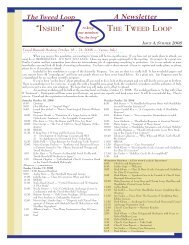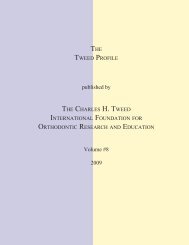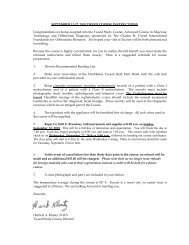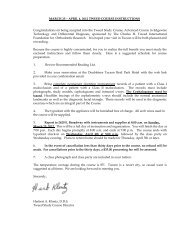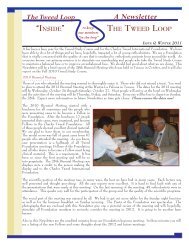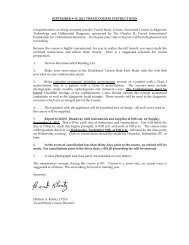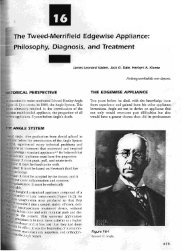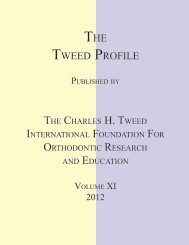the tweed profile - The Charles H. Tweed International Foundation
the tweed profile - The Charles H. Tweed International Foundation
the tweed profile - The Charles H. Tweed International Foundation
You also want an ePaper? Increase the reach of your titles
YUMPU automatically turns print PDFs into web optimized ePapers that Google loves.
tooth alignment. Long term stability of a malocclusion<br />
correction is an achievable goal.<br />
CONCLUSIONS<br />
<strong>The</strong> articles confirm some common findings. For<br />
mean changes in arch width from each study, refer to<br />
Table I and II.<br />
1. In both extraction and non-extraction patients,<br />
mandibular intercanine width increases during<br />
treatment and decreases posttreatment.<br />
2. Mandibular intermolar width changes are different<br />
between <strong>the</strong> extraction and non-extraction<br />
groups during treatment; <strong>the</strong> width decreases in<br />
<strong>the</strong> extraction group and increases in <strong>the</strong> nonextraction<br />
group.<br />
3. Maxillary intercanine width increases during<br />
treatment in both <strong>the</strong> extraction and non-extraction<br />
cases.<br />
4.<br />
5.<br />
6.<br />
Maxillary intermolar width changes differently<br />
between <strong>the</strong> extraction and non-extraction<br />
groups during treatment; <strong>the</strong> width decreases in<br />
<strong>the</strong> extraction group and increases in <strong>the</strong> nonextraction<br />
group.<br />
In various studies of non-extraction treatment with<br />
distal movement of one or both arches, overall<br />
long-term stability was achieved. According to<br />
<strong>the</strong> articles, proper mechanics is required and<br />
providing prolonged retention is suggested.<br />
When evaluating premolar extraction treatment,<br />
long-term stability turned out to be successfully<br />
achieved even after <strong>the</strong> significant decrease in<br />
arch width in <strong>the</strong> premolar and molar regions<br />
and <strong>the</strong> subsequent decrease in intercanine width<br />
posttreatment. <strong>The</strong> success is due to evidence<br />
based treatment objectives and <strong>the</strong> clinicians’<br />
diagnostic and treatment ability.<br />
23



